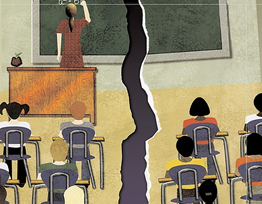Latino-White Achievement Gap Unchanged
WASHINGTON -In a first-of-its kind report released today by the National Center for Education Statistics (NCES) it was revealed that In 20 years, the national achievement gap between Hispanic students and their non-Hispanic white peers hasn’t budged.
 The report comes as Congress is considering how to rewrite No Child Left Behind, the federal law that has attempted to narrow gaps based on race, income, and other factors. Questions loom about how much of that accountability system will stay in place, and what specific role the federal government will play in pushing for the progress of Hispanic students.
The report comes as Congress is considering how to rewrite No Child Left Behind, the federal law that has attempted to narrow gaps based on race, income, and other factors. Questions loom about how much of that accountability system will stay in place, and what specific role the federal government will play in pushing for the progress of Hispanic students.
National Assessment of Educational Progress Highlights Academic Achievement of Fastest Growing Segment of U.S. Population Hispanic students are now the secondâ€Âlargest racial/ethnic student population in the United States. In the past 40 years, the Hispanic student population at the fourth grade has increased from less than 2 percent to 21 percent of the nation’s fourthâ€Âgraders.
This report is the first to present comprehensive national and state data on the performance of these students in comparison to their White peers. The scores for Hispanic students have increased over time, yet the gap between this student group and their White counterparts is unchanged, according to Achievement Gaps: How Hispanic and White Students in Public chools Perform in Mathematics and Reading on the National Assessment of Educational Progress (NAEP), released today by the National Center for Education Statistics (NCES).
This report provides detailed information on the achievement gap between Hispanic and White public school students in grades 4 and 8 at the national and state levels since the 1990s. It also describes how those gaps have changed over time and looks at performance f specific student demographic groups, such as those designated as English Language Learners (ELL) or as eligible for the National School Lunch Program (NSLP).
“While the Hispanicâ€ÂWhite achievement gap remains wide, we are pleased to see the rogress made by Hispanic students in both reading and math,” said NCES Commissioner Jack Buckley.
Since the earliest comparison year, the White – nonâ€ÂELL gap narrowed in both reading and athematics. These students perform at a level closer to that of their White peers than those classified as ELLs.
Additional findings from Achievement Gaps: How Hispanic and White Students in Public chools Perform in Mathematics and Reading on the National Assessment of Educational progress (NAEP) include:
- At the national level, achievement gaps between Hispanic and White students at grades 4 and 8 in mathematics and reading is about 20 points on the NAEP scale.
- Five states/jurisdictions have a smaller gap than the nation for both reading and mathematics at grades 4 and 8, including Department of Defense Education Activity schools, Florida, Kentucky, Missouri, and Wyoming.
- California and Connecticut each had a Hispanic – White gap larger than the nation for grades 4 and 8 math ematics and for grade 4 reading.
- In 2009, the 15â€Âpoint reading gap between grade 4 White and nonâ€ÂELL Hispanic students was narrower than the 24â€Âpoint gap in 1998. Scores increased for both groups but the increase was larger for nonâ€ÂELL Hispanic students. At grade 4, the achievement gap was not statistically different from 1998 to 2009.
- In 2009, the 15â€Âpoint reading gap between grade 8 White and nonâ€ÂELL Hispanic students was narrower than the 22â€Âpoint gap in 1998, but not significantly different in 2009 than the gap in 2007. Scores increased for both groups but the increase was larger for nonâ€ÂELL Hispanic students. The reading achievement gap between nonâ€ÂELL and ELL Hispanic students was 39 points at grade 8.
- In 2009, in grade 4 mathematics, the gap between White students eligible and not eligible for NSLP was 17 points, while the gap between the same groups—eligible and notâ€Âeligible for NSLP—of Hispanic students was 12 points. This pattern is similar at grade 4 reading.
- In 2009, in grade 8 mathematics, the gap between White students eligible and not eligible for NSLP was 21 points, while the gap between the same groups—eligible and notâ€Âeligible for NSLP—of Hispanic students was 12 points. This pattern is similar at grade 8 reading. The National Center for Education Statistics is the statistical center of the Institute of Education Sciences in the U.S. Department of Education.










